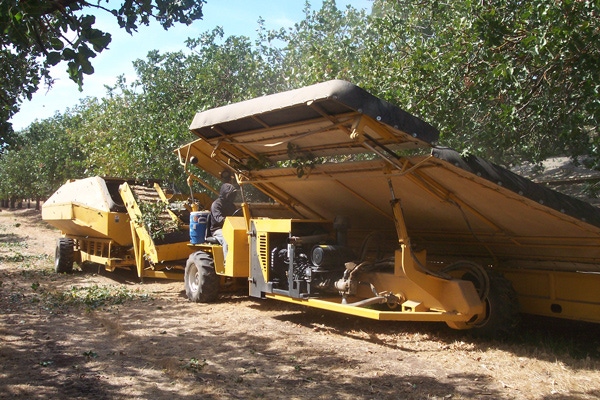October 6, 2016

This has not been a typical growing season for pistachio grower Rod Stiefvater, whose company RTS Agribusiness manages pistachio orchards in California’s Fresno, Kern, Madera, and Tulare counties.
His Kern County harvest got off to the earliest start ever on Aug. 23. That was 10 days earlier than last year’s start when harvest began at the normal time.
Also, a surprisingly wide variation in crop maturity, plus a high number of early splits, prompted Stiefvater to go with a two-shake harvest for all trees to minimize damage to the crop from Navel orangeworm (NOW). This was a first for him.
In the past, a large variation in maturity typically has been a concern to Stiefvater only in a relatively few of his orchards.
Dividing his harvest into two shakes reduces daily truck load volume by spreading it over a longer period. This will help his packer handle this year’s large crop, he says.
As Stiefvater finished his first shake in early September, he was puzzled by something he hadn’t seen in his 30 years as a pistachio grower – a high number of dehydrated nuts, both in and under some trees in some fields.
“I first noticed this in June on the west side of Kern County where those trees shed many more nuts than usual for that time of year,” he says. “Many of the nuts remaining in the trees continued to dry out and didn’t drop until we shook them. There was a lot of shriveled product on the ground. ”
Blowers on his receivers and elevators separated many of the shriveled nuts from the good ones. While he can’t explain the reason for so many dehydrated nuts, he attributes them to higher-than-expected production in his orchards and recent warm winters.
“Although yields look good so far, they’re still about 15 to 20 percent less than I anticipated earlier in the season, based on what I was seeing on the trees then,” Stiefvater says.
While not as large as first expected, the prospect of a good size crop this year is especially good news to for Stiefvater and other California growers, who account for about 98 percent of U.S. pistachio production.
Last year, they were disappointed to harvest just 271 million pounds, or 40 percent short of projections made early in 2015 before the full impact of continuing drought and insufficient winter chilling hours became apparent.
Stiefvater rates the quality of his 2016 pistachio crop as good. Although varying in size, the nuts are slightly smaller than usual in some fields, he notes. Even though his split numbers have been high, Stiefvater says other growers have experienced a high percentage of closed shells.
He expected to start his second shake in mid-September and to finish harvest by month’s end.
The idea of a two-shake harvest is to harvest the earlier-maturing nuts as soon as possible to minimize exposure to NOW. The longer the nuts remain on trees then the higher the infection risk.
“Pressure in our orchards this year from Navel orangeworm has been spotty,” Stiefvater says. “It’s ranged from very little in some areas, normal in others, and severe in a few isolated cases.”
In Kern County where the California harvest generally begins, most orchards have required a two-shake harvest. A few growers shook trees on Aug. 17. Within the next five days, harvest in most orchards was underway. Aided by ideal weather, harvest was expected to wrap up by the third week of September.
You May Also Like




